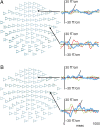Musical intervention enhances infants' neural processing of temporal structure in music and speech
- PMID: 27114512
- PMCID: PMC4868410
- DOI: 10.1073/pnas.1603984113
Musical intervention enhances infants' neural processing of temporal structure in music and speech
Abstract
Individuals with music training in early childhood show enhanced processing of musical sounds, an effect that generalizes to speech processing. However, the conclusions drawn from previous studies are limited due to the possible confounds of predisposition and other factors affecting musicians and nonmusicians. We used a randomized design to test the effects of a laboratory-controlled music intervention on young infants' neural processing of music and speech. Nine-month-old infants were randomly assigned to music (intervention) or play (control) activities for 12 sessions. The intervention targeted temporal structure learning using triple meter in music (e.g., waltz), which is difficult for infants, and it incorporated key characteristics of typical infant music classes to maximize learning (e.g., multimodal, social, and repetitive experiences). Controls had similar multimodal, social, repetitive play, but without music. Upon completion, infants' neural processing of temporal structure was tested in both music (tones in triple meter) and speech (foreign syllable structure). Infants' neural processing was quantified by the mismatch response (MMR) measured with a traditional oddball paradigm using magnetoencephalography (MEG). The intervention group exhibited significantly larger MMRs in response to music temporal structure violations in both auditory and prefrontal cortical regions. Identical results were obtained for temporal structure changes in speech. The intervention thus enhanced temporal structure processing not only in music, but also in speech, at 9 mo of age. We argue that the intervention enhanced infants' ability to extract temporal structure information and to predict future events in time, a skill affecting both music and speech processing.
Keywords: MEG; early experience; infants; music; speech.
Conflict of interest statement
The authors declare no conflict of interest.
Figures



Similar articles
-
Neural processing of musical meter in musicians and non-musicians.Neuropsychologia. 2017 Nov;106:289-297. doi: 10.1016/j.neuropsychologia.2017.10.007. Epub 2017 Oct 4. Neuropsychologia. 2017. PMID: 28987905
-
Music listening engages specific cortical regions within the temporal lobes: differences between musicians and non-musicians.Cortex. 2014 Oct;59:126-37. doi: 10.1016/j.cortex.2014.07.013. Epub 2014 Aug 12. Cortex. 2014. PMID: 25173956
-
Music training enhances the automatic neural processing of foreign speech sounds.Sci Rep. 2017 Oct 3;7(1):12631. doi: 10.1038/s41598-017-12575-1. Sci Rep. 2017. PMID: 28974695 Free PMC article.
-
Neural sensitivity to statistical regularities as a fundamental biological process that underlies auditory learning: the role of musical practice.Hear Res. 2014 Feb;308:122-8. doi: 10.1016/j.heares.2013.08.018. Epub 2013 Sep 12. Hear Res. 2014. PMID: 24035820 Review.
-
Music perception: information flow within the human auditory cortices.Adv Exp Med Biol. 2014;829:293-303. doi: 10.1007/978-1-4939-1782-2_15. Adv Exp Med Biol. 2014. PMID: 25358716 Review.
Cited by
-
A Dynamical, Radically Embodied, and Ecological Theory of Rhythm Development.Front Psychol. 2022 Feb 24;13:653696. doi: 10.3389/fpsyg.2022.653696. eCollection 2022. Front Psychol. 2022. PMID: 35282203 Free PMC article. Review.
-
Is atypical rhythm a risk factor for developmental speech and language disorders?Wiley Interdiscip Rev Cogn Sci. 2020 Sep;11(5):e1528. doi: 10.1002/wcs.1528. Epub 2020 Apr 3. Wiley Interdiscip Rev Cogn Sci. 2020. PMID: 32244259 Free PMC article. Review.
-
Temporal Structure of Music Improves the Cortical Encoding of Speech.Hum Brain Mapp. 2025 Apr 1;46(5):e70199. doi: 10.1002/hbm.70199. Hum Brain Mapp. 2025. PMID: 40129256 Free PMC article.
-
Reflections on the past two decades of Mind, Brain, and Education.Mind Brain Educ. 2024 Feb;18(1):6-16. doi: 10.1111/mbe.12407. Epub 2024 Mar 2. Mind Brain Educ. 2024. PMID: 38745857 Free PMC article. No abstract available.
-
Exaggeration of Language-Specific Rhythms in English and French Children's Songs.Front Psychol. 2016 Jun 21;7:939. doi: 10.3389/fpsyg.2016.00939. eCollection 2016. Front Psychol. 2016. PMID: 27445907 Free PMC article.
References
-
- Zatorre RJ. Predispositions and plasticity in music and speech learning: Neural correlates and implications. Science. 2013;342(6158):585–589. - PubMed
-
- Koelsch S, Schröger E, Tervaniemi M. Superior pre-attentive auditory processing in musicians. Neuroreport. 1999;10(6):1309–1313. - PubMed
-
- Fujioka T, Ross B, Kakigi R, Pantev C, Trainor LJ. One year of musical training affects development of auditory cortical-evoked fields in young children. Brain. 2006;129(Pt 10):2593–2608. - PubMed
-
- Pantev C, et al. Increased auditory cortical representation in musicians. Nature. 1998;392(6678):811–814. - PubMed
-
- Vuust P, et al. To musicians, the message is in the meter pre-attentive neuronal responses to incongruent rhythm are left-lateralized in musicians. Neuroimage. 2005;24(2):560–564. - PubMed
Publication types
MeSH terms
LinkOut - more resources
Full Text Sources
Other Literature Sources

